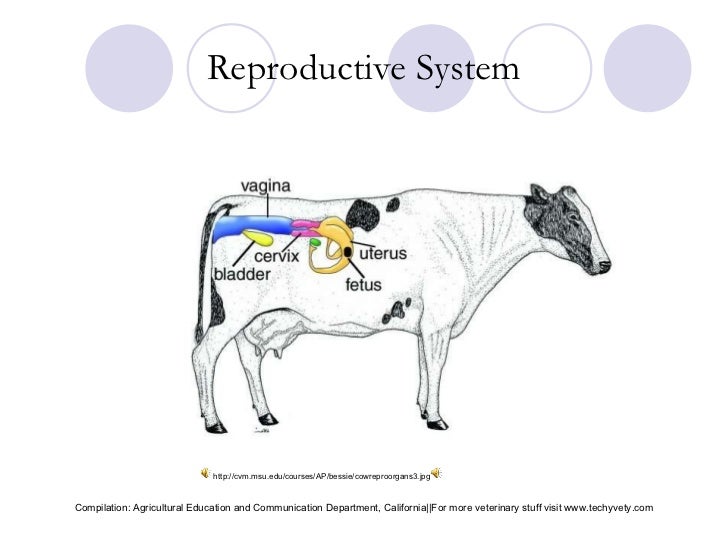Reproduction in Farm Animals
Reproduction in farm animals is a critical biological process that ensures the continuation of species and supports the production of meat, milk, wool, and other animal products. It involves complex physiological, hormonal, and behavioral processes. Below is a detailed discussion of the reproductive systems, processes, and management practices in farm animals.
a) Male Reproductive System
The male reproductive system is responsible for producing and delivering sperm to fertilize the female’s egg.
- Testes: Located in the scrotum, outside the body cavity, to maintain a lower temperature for sperm production. Produce sperm (spermatogenesis) and the hormone testosterone, which regulates male characteristics and libido.
- Epididymis: A coiled tube attached to the testes where sperm mature and are stored.
- Vas Deferens: A muscular tube that transports mature sperm from the epididymis to the urethra during ejaculation.
- Accessory Glands: Include the seminal vesicles, prostate gland, and bulbourethral glands. These glands produce seminal fluid, which nourishes and protects sperm, forming semen.
- Penis: The organ used to deposit semen into the female’s reproductive tract during mating.

b) Female Reproductive System
The female reproductive system produces eggs, supports fertilization, and nurtures the developing fetus.
- Ovaries: Produce eggs (ova) and hormones like estrogen and progesterone. Eggs are released during ovulation, which occurs in a cyclical pattern (estrous cycle).
- Oviduct (Fallopian Tube): The site of fertilization, where sperm meets the egg. Transports the fertilized egg (zygote) to the uterus.
- Uterus: A muscular organ where the fertilized egg implants and develops into a fetus. The uterus is divided into two horns in animals like cows and pigs.
- Cervix: A thick-walled structure that separates the uterus from the vagina. Acts as a barrier to protect the uterus from infections and opens during parturition (birth).
- Vagina: Receives sperm during mating and serves as the birth canal during parturition.
Reproductive Processes in Farm Animals
a) Estrous Cycle
The estrous cycle is the reproductive cycle in female animals, characterized by hormonal changes and behavioral signs.
- Proestrus: Follicles in the ovary grow and produce estrogen. The female shows signs of sexual receptivity but does not allow mating.
- Estrus (Heat): The female is sexually receptive and allows mating. Ovulation occurs, releasing an egg from the ovary.
- Metestrus: The corpus luteum forms from the ruptured follicle and secretes progesterone. Progesterone prepares the uterus for pregnancy.
- Diestrus: If fertilization occurs, the corpus luteum persists to maintain pregnancy. If fertilization does not occur, the corpus luteum regresses, and the cycle repeats.
- Anestrus: A period of reproductive inactivity, often seen in seasonal breeders like sheep and goats.
b) Mating and Fertilization
- Natural Mating: The male mounts the female and deposits semen into her reproductive tract.
- Artificial Insemination (AI): Semen is collected from a male, processed, and artificially introduced into the female’s reproductive tract. AI allows the use of superior genetics and reduces the risk of disease transmission.
c) Gestation (Pregnancy) The period from fertilization to birth.
- Duration varies by species:
- Cattle: ~280 days
- Bufflow ~310 days
- Sheep: ~150 days
- Pigs: ~114 days
- Goats: ~150 days
- The developing fetus receives nutrients and oxygen from the mother through the placenta.
d) Parturition (Birth)
- Hormonal changes, including a rise in cortisol and a drop in progesterone, trigger labor.
- The fetus is expelled through the birth canal.
- After birth, the placenta is expelled, and the mother begins lactation to feed the newborn.
Factors Affecting Reproduction
- Nutrition Proper nutrition is essential for reproductive health. Deficiencies in energy, protein, vitamins (A, D, E), and minerals (calcium, phosphorus) can impair fertility.
- Health Diseases like brucellosis, leptospirosis, and mastitis can reduce fertility. Regular vaccination and biosecurity measures are crucial.
- Environment Temperature, lighting, and housing conditions affect reproduction. Stress from overcrowding or poor management can reduce fertility.
- Genetics Selective breeding improves reproductive traits like fertility, litter size, and growth rate.
Reproductive Technologies
- Artificial Insemination (AI) Semen is collected, processed, and introduced into the female’s reproductive tract. Widely used in cattle, pigs, and sheep to improve genetics.
- Embryo Transfer Embryos are collected from a high-quality female and implanted into a surrogate mother. Used in cattle to produce multiple offspring from elite females.
- Hormonal Treatments Hormones like prostaglandins and GnRH are used to synchronize estrus or induce ovulation.
- Genetic Engineering Techniques like CRISPR are used to modify genes for improved reproductive traits.

